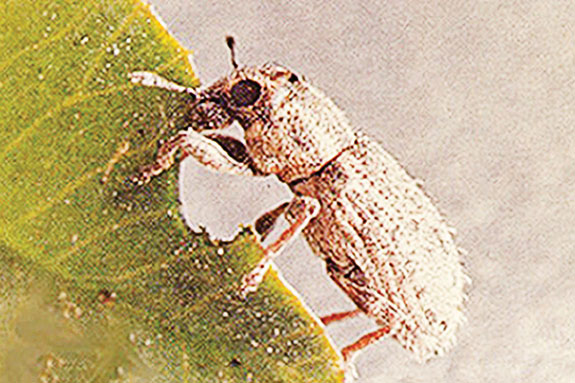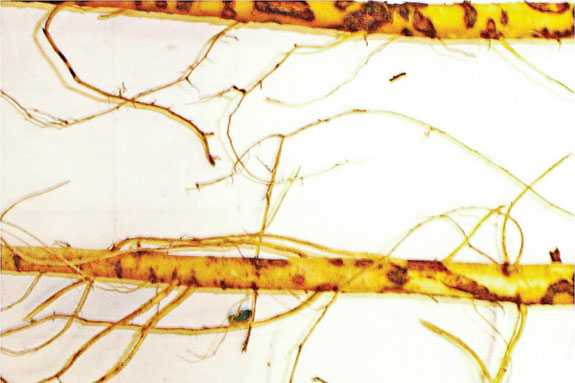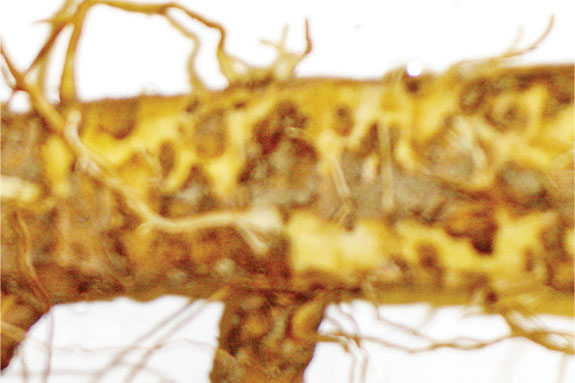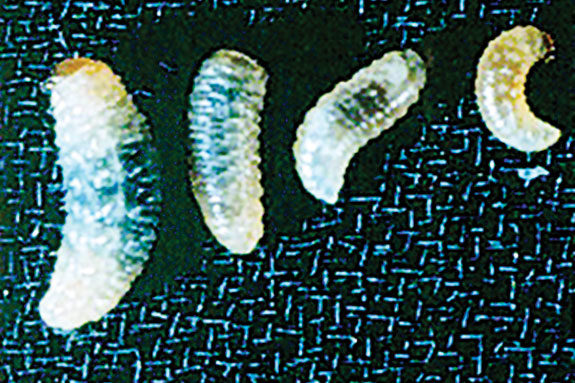In 1997, I informed Extension Entomologist Dr. Baird regarding the severity and devastating impact of the clover root curculio (CRC) on alfalfa fields.
Over the past 10 years the CRC population has increased dramatically and is having a devastating effect on growers’ fields in Elmore and Owyhee counties.
I have evaluated hundreds of growers’ fields in the area and many samples from other counties and states as well. The majority of fields and samples had some CRC damage
The underlying problem has been a lack of common knowledge and public awareness. CRC damage characteristics usually have been misinterpreted and treated as nutrient deficiencies, disease problems or attributed to other insects.
In cooperation with two entomologists, in 1997 we published and distributed over 300 copies of CRC Fact Sheet #1 which describes the CRC life cycle, damage, host plants, detection and cultural controls. In addition, I have given an average of two field demonstrations a year to educate growers.

Biology of the CRC
Adult CRC weevils are dark gray to black, about 1/8- to 1/4-inch long and have a short snout and deeply punctured appearance on the head, thorax and abdomen.
Larvae are small white grubs about 1/4-inch long, with a dark brown head and no legs. They are usually found in the soil close to alfalfa root systems.
Normally the CRC overwinters as an adult weevil, laying eggs in the spring, but eggs may be laid in the fall or winter and overwinter until spring in mild seasons.
In the spring adults become active, depositing eggs on the soil surface or on the undersides of leaves of alfalfa, clover or other preferred host plants. The larvae hatch by May or early June and move into the soil, where they feed on the root system during their entire development period.
Damage
• Adults feed on foliage, leaving half-circle holes along the leaf margins.

• While damage from adult feeding may be insignificant in established stands, it can be very injurious to new seedlings where springtime damage may result in serious stand loss.
• The most serious damage is caused by larval feeding on the main tap root, which weakens the plant and allows entry to disease pathogens which result in bacterial wilt and root rot.
• Affected alfalfa and clover will wilt and often die, especially if water-stressed.
• Alfalfa stands often lose productivity much sooner where CRC are prevalent.
There is no chemical currently registered for the control of CRC
No insecticide available for agricultural use today has proven effective. During the 1940s and 1950s, CRC was probably maintained at low levels by older chlorinated hydrocarbon insecticides, which are no longer being used.
In cooperation with field advisers, growers and industry researchers, I have evaluated different rates of new chemicals on alfalfa fields. The results were inconclusive and were not cost-effective.
As an alternative, I have evaluated the following cultural practices, which have proven to be effective in helping to decrease CRC damage:

Crop rotation
• Growers should rotate their fields away from susceptible forage crops more frequently when CRC are a problem.
• Avoid leaving alfalfa or clover in a field beyond productive life.
• Rotation including potatoes, sugar beets or other cultivated crops will help eliminate the pest.
• Soil insecticides applied for wireworms, nematodes and root maggots during non-alfalfa years may help prevent CRC buildup and damage when alfalfa is again planted.
Plowing
• Late fall plowing of CRC-infested alfalfa or clover will expose the beetles and larvae to killing conditions and natural predators.
• Late summer or early fall plowing is not as effective.
Resistant varieties
• Use a variety of alfalfa or clover known to have resistance to CRC attack when replanting.
• Lahontan has shown some resistance to CRC damage.
Chemical control
• There are no soil insecticides registered for use on established alfalfa or clover, and distribution would be difficult in the more compacted soils of perennial forage crops.
• Soil insecticides applied during rotation to potatoes, beets or other crops may help reduce CRC numbers.
• Soil fumigation for forage crops is effective but not cost-efficient.
• Foliar treatments are ineffective overall. While spring applications for alfalfa weevil do kill adult CRC and exposed larvae, larvae in the soil are not affected.
Agronomic practices
• CRC damage is usually noticed as crop wilting or slow growth the first year after fall seeding.
• Damage is more prevalent in the new, fast-recovering alfalfa varieties.
• Make sure fertility levels are adequate and that plants are not water-stressed during mid-summer heat.
• After this time, stands tend to recover and may last two to three years before rotating to another crop.
Irrigation management
Monitor soil moisture and adjust irrigation to prevent oversaturated or overdry soils. FG
For further information regarding the clover root curculio, please contact Mir at the University of Idaho Extension Office.
PHOTOS
The underlying problem has been a lack of common knowledge and public awareness. Clover root curculio damage characteristics usually have been misinterpreted and treated as nutrient deficiencies, disease problems or attributed to other insects. Photos courtesy of Mir Seyedbagheri.







